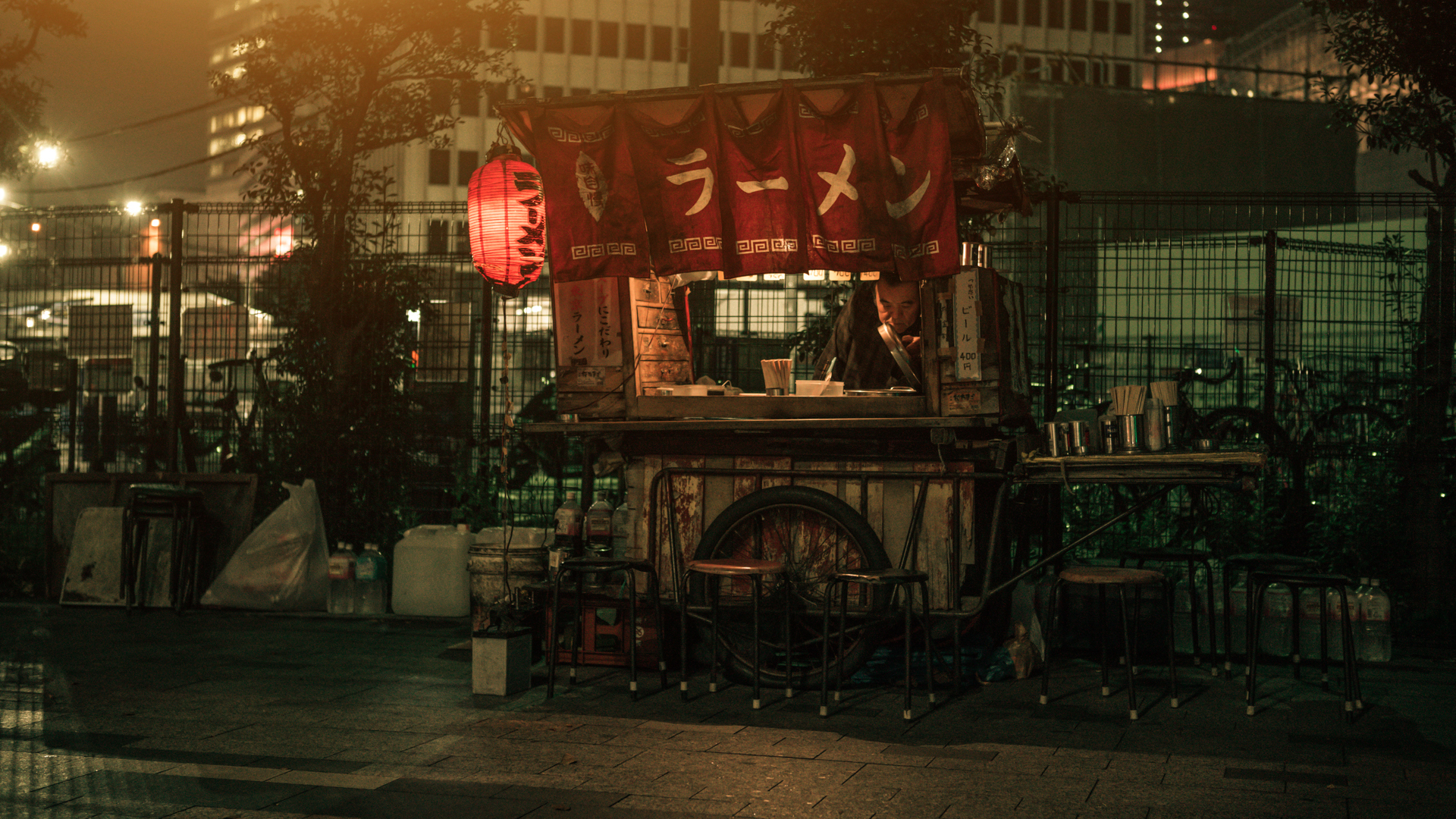April 14, 2017
What Are The Odds Of Being A Hero Or A Villain?
Have you ever wanted to have a superpower? What would it be and would you use it to be a hero or a villain? This infographic takes a look at how 2,000 men and women would use their superpowers if they had some.

The survey found that 24 percent of women would want to have super healing power, 19 percent said they’d want a time traveling ability, and more than 14 percent of surveyed women said super intelligence was their preferred power. 29 percent of men surveyed, on the other hand, said they would want the ability to time travel.
When asked what they would do with their abilities, 21 percent of women confessed that they would use time travel to eliminate their enemies and 67 percent of men said revealed that they wanted to use x-ray vision to see through clothes. Men were also more likely (28 percent) to use mind control to make someone fall in love with them.

Surveyed participants that fell within the millennial age range were more likely to say that time travel was their preferred ability while those in Generation X and baby boomer categories favored super healing. Another major difference between generations was that millennials were more likely to risk their pet’s life to use x-ray vision (24 percent), while only 19 percent of Gen Xers and 16 percent of baby boomers would do so. 33 percent of millennials also said that they would risk a stranger’s life for the chance to fly.


The survey also found that, regardless of religion, many people would use mind control to help politicians see eye to eye rather than force someone to fall in love with them or use super speed to generate an unlimited supply of free energy over breaking every record at the Olympics. As far as time travel goes, most of those surveyed said they would go back in time to bet on the Cubs winning the 2016 world series, while the answers were split when it came to going back in time to save President John F. Kennedy or Martin Luther King Jr. When it comes to flying, more than half of the respondent that makes $25,000 a year or more preferred to fly to a dream vacation destination rather than rescue people from war-torn countries.

When it comes to money, of the 2,000 men and women surveyed, over 41 percent said they would prefer to be Superman than win $100 million, while only 20 percent said they’d prefer to be Wonder Woman and even fewer said they’d rather be Captain America or Batman (19 percent and 11 percent respectively).
Source: Visual News
April 13, 2017
Status Updates or Photos: Learn Which Facebook Posts Get the Most Likes
Ever wonder if Facebook posts published on the weekend get more likes than those posted on weekdays? Are people more likely to share Facebook posts that feature a photo more or ones that are simple status updates?
Using data from a research paper published in the Journal of Business Research, I try to explore what days and types of posts get the most likes, comments, and shares of a Facebook post. The data set used consists of 500 Facebook posts in 2014 from a worldwide cosmetics company with a renowned brand.
Weekdays Get More Facebook Interactions Than Weekends
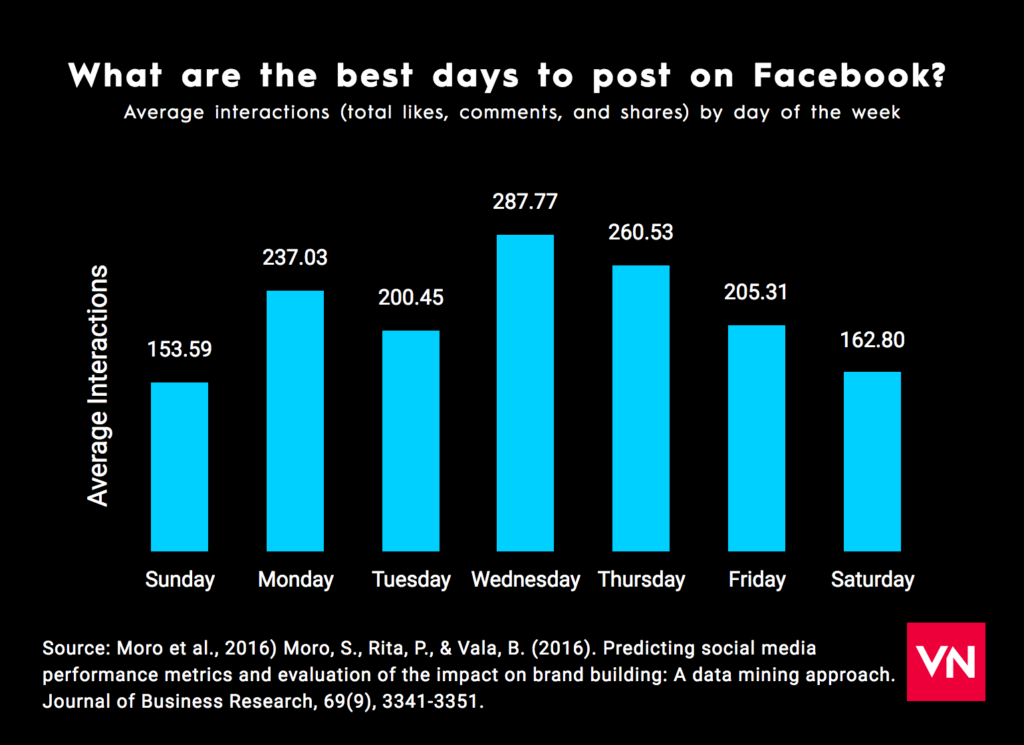
Surprisingly, weekdays seem to have more post interactions than weekends. Initially I thought that weekends would have more interactions since people have more free time to browse Facebook on Saturdays and Sundays. It looks like Wednesdays are the best days for social media managers to post on Facebook. Maybe people need a little social media pick-me-up to get through the midweek doldrums.
Videos Get the Most Likes, Comments, and Shares
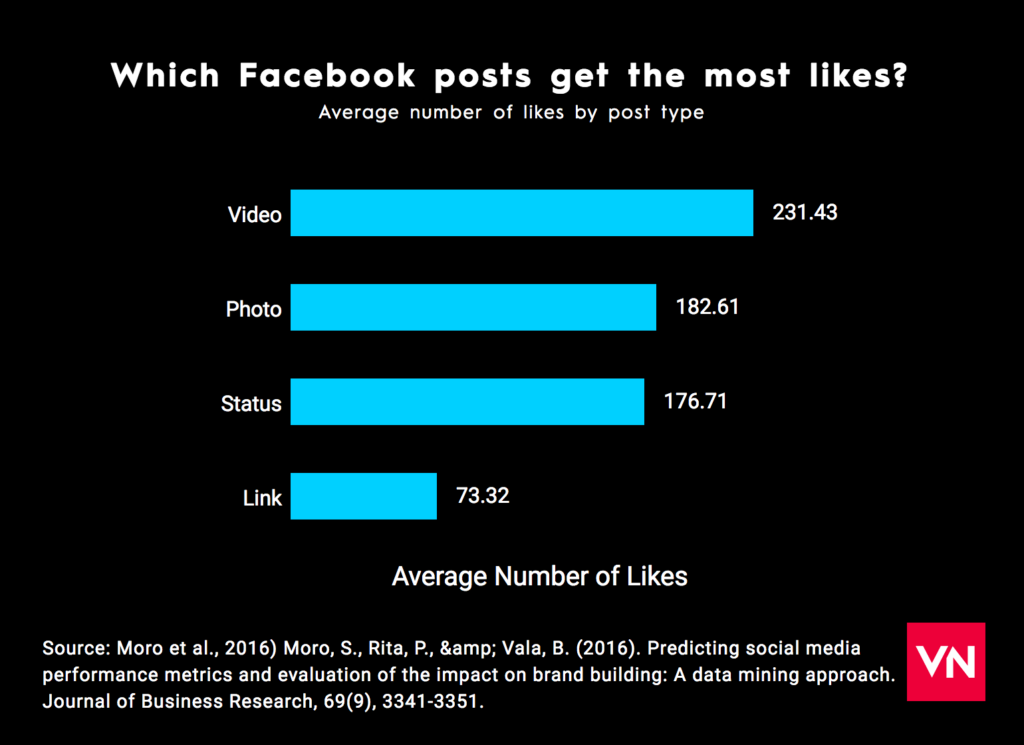
Interestingly photos and status have a similar amount of likes and links trail far behind all other types of post content. I suspected that visuals would perform much better than simple status updates but the data tells us otherwise.

Comments can be positive or negative so it can be used as a measure the amount of engagement a Facebook user has with a specific post. Simple status updates could signify that a brand is trying to communicate with a user on a more personal level and can help start conversations.
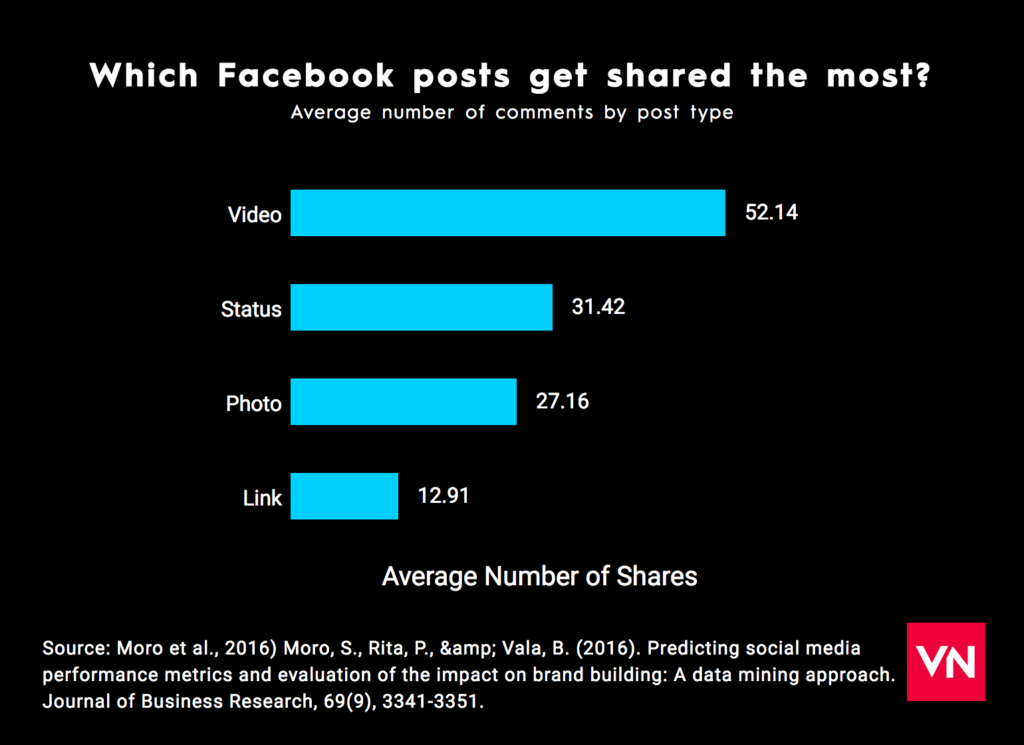
Shares allows the network of the user to also see the original Facebook post. This creates more visibility for the post. Again, status updates and photos perform similarly with links trailing far behind.
Overall, videos create the most amount of interactions with a post. Links perform the worst when it comes to generating interactions. Many businesses use their Facebook as a way to build their brand. These businesses also use Facebook as a way to create a link between social media and their website. The data shows this is not the best way to create brand awareness. Businesses should actively seek to engage with people in a personable and fun way. Videos, status updates, and photos seem to do this best. If you need an example of the power of social media, look at Oreo’s marketing strategy.
Source: Visual News
April 13, 2017
Photojournalism: Cinematic Tokyo by Stijn Hoekstra
Photojournalism: Cinematic Tokyo by Stijn Hoekstra
Tokyo Tokyo Tokyo. A city I miss dearly! To remedy to my sadness (hah), let’s take a look at the photojournalism project by Stijn Hoekstra. Named Cinematic Tokyo (the project title says it all), I love his approach from a cinematic perspective considering that is also part of his daytime job which makes it even more perfect with Tokyo as a working environment. It’s such a busy city that Stijn captured moments that makes us feel we are in an actual movie which makes it quite interesting.
Published on Behance is the work from Stijn Hoekstra who is a freelance cinematographer and photographer based in Amsterdam, Netherlands. If you love his style, you should definitely follow his Instagram for more of his work.
AoiroStudio
Apr 13, 2017
Source: Abduzeedo Photography
April 13, 2017
Illustration & Painting: Futurism vs. Passeism
Illustration & Painting: Futurism vs. Passeism
Let’s take a pause and look at this illustration series by Oleg Belinsky named Futurism vs. Passeism. You’ll notice the mixture of that black solid colour, geometrics, lighting and gradients are just a combination of a stunning stylish art. I really love the tone and the details given to the white colour, just add an incredible final touch. I wish there was more of this series but time will let us know and I can’t wait to see more of Oleg’s work in the near future. Hope you dig it as well!
Published on Behance, this is the work from Oleg Belinsky who is a designer from Salaspils, Latvia. Being living close to the Baltic Sea, inspiration must have been coming from your surroundings. You should definitely follow his work.
AoiroStudio
Apr 13, 2017
Source: Abduzeedo Illustration
April 13, 2017
Filmmaker In Focus Series: Virtual Reality Grand Jury Winners
While SXSW has been showcasing VR projects in many different ways for years, 2017 marks the first year we expanded our program and added Virtual Cinema. We had two different categories, 360° Video and Room-Scale. Our inaugural jury winners for VR are Lindsay Branham and Jonathan Olinger for Behind the Fence (360°) and Cassandra Herrman and Lauren Mucciolo for After Solitary (room-scale).
Behind the Fence

Q: Tell us a little about your film?
A: “Behind the Fence is an immersive virtual reality documentary that takes you inside the 5×5 square mile camp that imprisons 140,000 Rohingya Muslims in Myanmar. This modern day concentration camp is home to the most persecuted people on earth. Behind the Fence profiles Abul, a husband who does everything he can to try to help his sick wife, Barbulu, a twelve-year-old boy whose future is diminished due to the constraints of living in this open air prison, and U Wirathu, the Buddhist leader of the 969 movement who stokes public support for restrictive laws that have rendered the Rohingya stateless in their own land.”
Q: What motivated you to tell this story?
A: “What the Rohingya are facing in Myanmar is not just another story of violence, persecution or displacement — this is systematic and calculated elimination, stoked by hate speech from extremist Buddhists. We chose VR because the situation facing the Rohingya Muslim minority in Myanmar is so dire and little known, that we hoped this nascent technology could amplify their entrapment to a world that has the power to prevent their annihilation.”
Q: Tell us a random fact?
A: “Past Fact: I went to 12 schools before I turned 18, and people often ask if that was hard. The truth is that I wouldn’t trade it – the exposure made me curious about everything and everyone and I have a kaleidoscope of memories and friends that span the world. Current Fact: I live in a house in Brooklyn with six other artists and we get to collaborate on a lot of our projects together, which I find very symbiotic.”
After Solitary

Q: Tell us a little about your film?
A: “After Solitary allows viewers to experience interactively the story of Kenny Moore, a recently released inmate who spent years at a stretch in solitary confinement.”
Q: What motivated you to tell this story?
A: “VR seemed an ideal medium to tell Kenny’s story and give viewers a visceral sense of the long-term effects of solitary confinement.”
Q: Tell us a random fact?
A: Cassandra: I once worked for a coffee exporting company in Burundi. Lauren: I lettered in bowling in high school.
Explore More Content From SXSW 2017
Get inspired by a multitude of diverse visionaries at SXSW – browse more 2017 Keynotes, Featured Sessions, Red Carpets, and Q&A’s on our YouTube Channel.
Follow us on Facebook, Twitter, Instagram, and SXSW News for the latest SXSW coverage, recaps, late-breaking announcements, and updates.
Behind the Fence answers by Lindsay Branham
The post Filmmaker In Focus Series: Virtual Reality Grand Jury Winners appeared first on SXSW.
Source: SxSW Film
April 13, 2017
Charting Housing Prices In Relation To Better Schools
If you have a family or you’re planning on starting one, good schooling is definitely something that you’ve thought about. For many city-dwelling families, it’s not unusual for them to make the transition from city life to the suburbs for better educational options and more space. But not all suburbs are similar and school district boundaries can make housing less affordable.
Although there are many elements to consider when determining a home price, economists have found that a 5 percent boost in test scores may raise housing prices by 2.5 percent in suburban neighborhoods and is, in fact, a common practice in many cities. But not all districts follow this model. Some schools can be found in districts that still have homes on the affordable side.
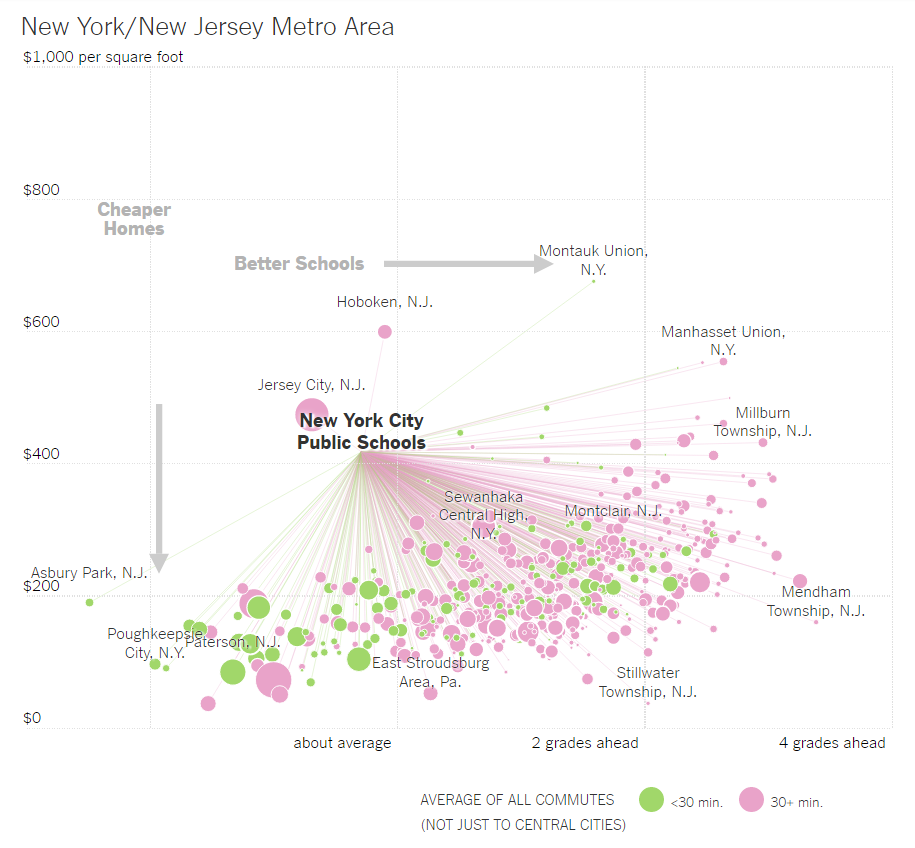
Using home price data from national real estate brokerage Redfin and school quality data based on test scores from the Stanford Education Data Archive, the New York Times developed a series of interactive charts for a project called Good Schools, Affordable Homes: Finding Suburban Sweet Spots that examine the relations between school quality, home price, and commute.
Their study found that some locations, such as cities with good public transit, the desire to live in the city center is more of a priority than school quality. The homes in these locations are typically more costly than homes farther from the city center and the study found that the prices in urban location have increased more rapidly than in the suburbs since 2000.

The most extreme example of this is found in the Bay Area. Many homes in the central city are so expensive, homeowners in suburban cities like San Ramon pay several hundred dollars less per square foot, a considerable price jump considering the schools are far better in San Ramon than in San Francisco. A point to consider, though, is that many of the city-dwellers might not have children yet, they might not want any children, or their children have already left the home.
Of course, these data displayed in the charts are district averages and there are variations depending on the city size (the larger the city, the greater the variation). Typically, though, those who choose to live in the suburbs end up saving money but the compromise is that they generally have longer commutes and don’t have access to urban amenities.
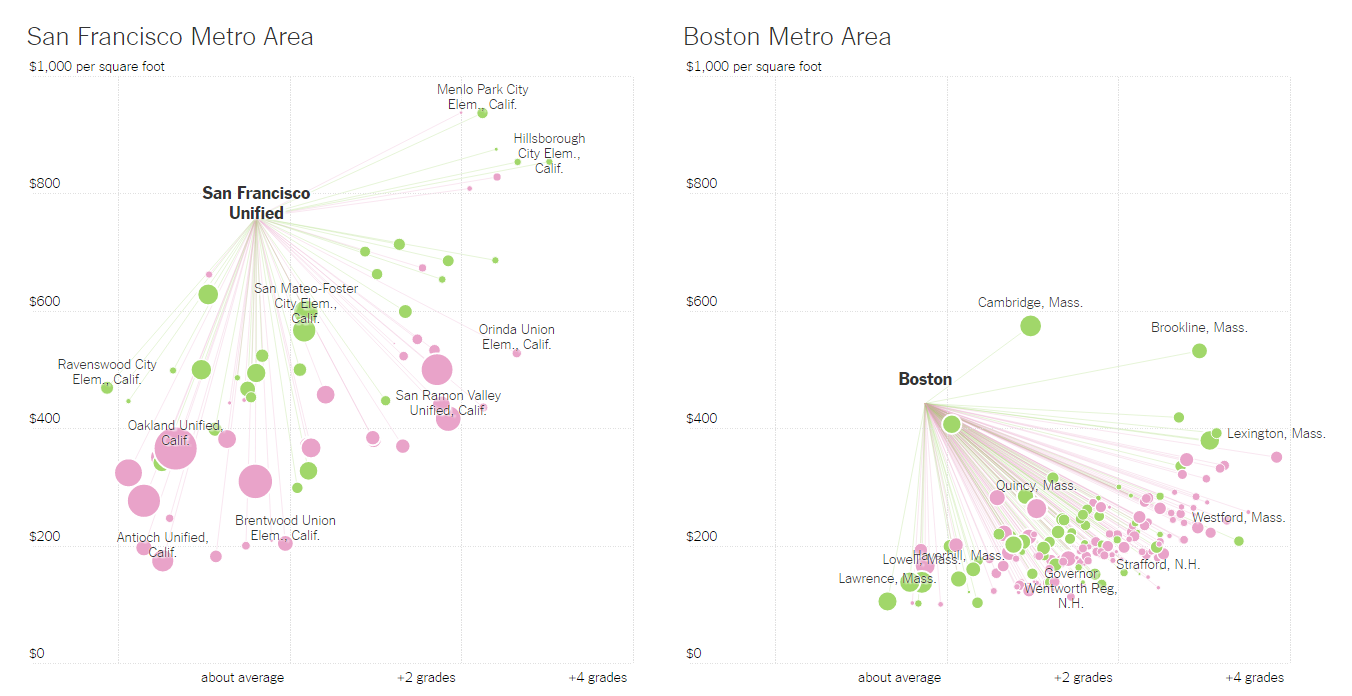
The Bay Area, New York, and Boston all have very similar characteristics: homebuyers’ desire to live in densely populated areas and a large portion of the population walks, bikes, or regularly takes public transit. Since a majority of the population in the rest of the U.S. drives, this creates a stark contrast between those living in metropolitan areas and those living in other locations across the country.
“Cities that have highly dense, highly urban center: The premium is higher in those places,” said Redfin’s chief economist Nela Richardson. “But in places like Phoenix, L.A., Dallas and Atlanta, the trade-off between living in the city and the suburbs is not as great, so why not go to where the best schools are and homes cost the least?”
Head on over to their site to get a better look at each district.
[Via: The New York Times]
Source: Visual News
April 12, 2017
Measuring Markets: Is VR/AR Going To Change The Game?
This article originally appeared on Visage.
Technology fads are met with a variety of responses: some people need it, some are moderately interested in it, and some want nothing to do with it. Virtual Reality (VR) and Augmented Reality (AR) are the newest arrivals. They come with plenty of hype, but will they really break through?
Though they’re exciting, these technologies have some stereotypes to overcome. VR/AR, along with those head-mounted-devices (HMDs), have largely been relegated to the video game world. In reality, VR/AR tech lends itself to a variety of different products and experiences.
VR transports the user to another world through the HMDs, giving them an immersive and responsive IMAX experience. AR allows users to see the physical world with added images and information through the HMD, kind of like Iron Man’s immersive vision. These technologies have many conceivable applications, but only if they are widely adopted.
The Future of VR/AR
As a new product enters the market, in order to project its success, initial barriers like stereotypes and developmental issues must play into the projection. When it comes to VR/AR, some projections give straightforward and optimistic figures, but this is not a very honest and realistic approach. Goldman Sachs released three different projections for the future of VR and AR by 2025, detailing the potential, the barriers, and the risks.
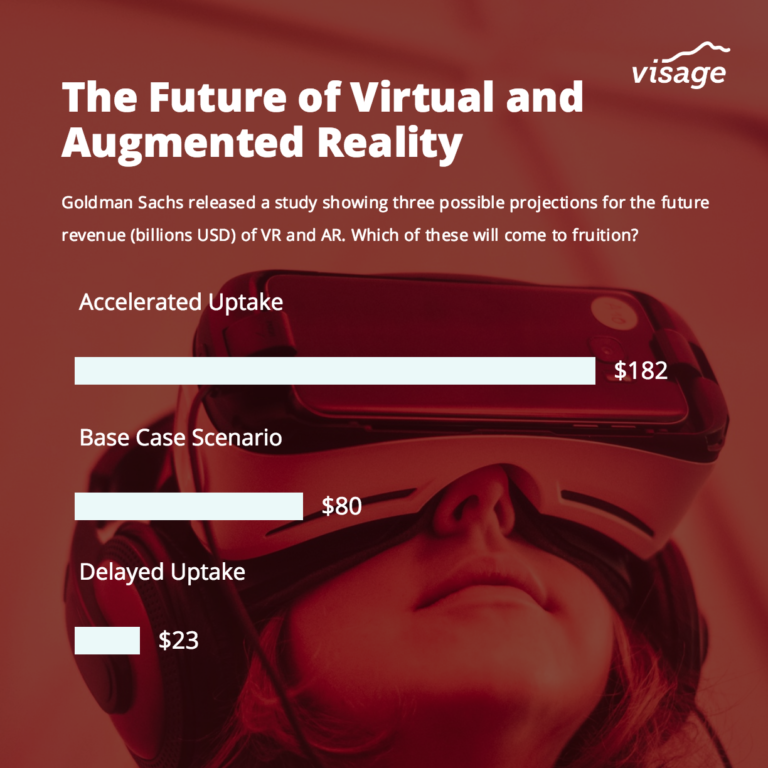
The “base case scenario” implies there will be success but also issues that stunt the overall growth and ability to reach all potential avenues. This moderate estimate predicts the HMDs do well in the market and in overall improvement in VR/AR technology, but mobility and battery life issues give a realistic middle ground estimate.
“Accelerated uptake” takes into account the success of VR/AR in industries other than just video games and entertainment, as well as vast improvements in mobility and battery life. “Delayed uptake” projects the future of VR/AR as staying in the niche video game world and lacking the overall proper improvements in the technology for it to branch out to other industries.
What Would Make VR/AR Succeed?
Both have potential use cases in a myriad of commercial industries. But right now so much pressure is placed on consumers in the video game and entertainment market to buy the required hardware to help kickstart this movement. Insufficient amounts of software and content, along with expensive price tags, are turning potential consumers into skeptics.
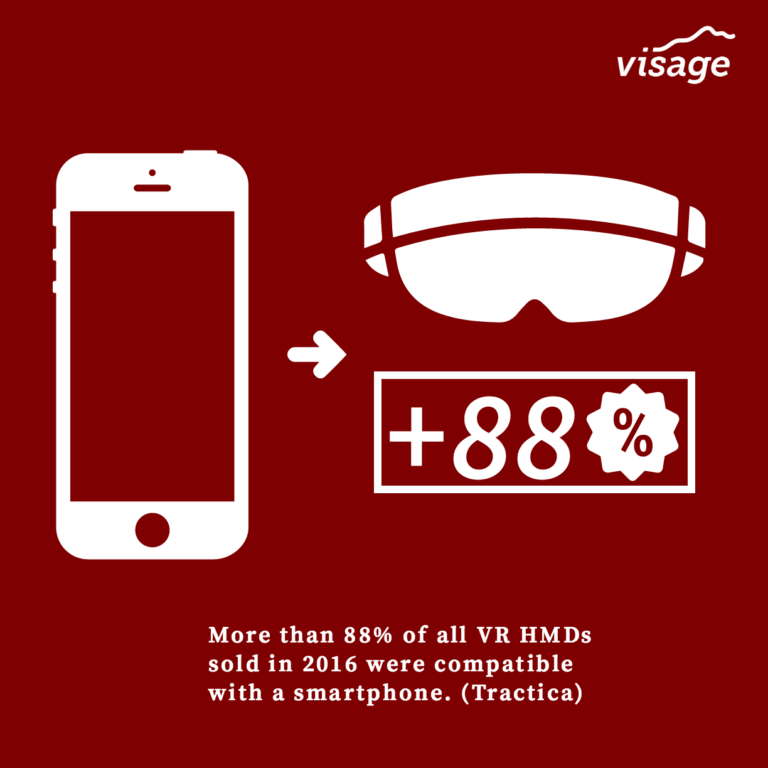
Targeting commercial enterprises could bring a sustainable future for VR/AR. This shift could change VR/AR into a tool, helping in everyday tasks. A new culture focusing on the technology as helpful and necessary—just like the smartphone—could help spark new interest while growing the market size.
The commercial ventures for VR/ AR could benefit:
- Healthcare
- Engineering
- Real Estate
- Military
- Education
- Retail
In these industries, VR/AR would serve well as a training tool, thanks to its immersive or augmented experience. (We currently share office space with Forklift-Simulator, a VR company that provides a lower-cost alternative to tremendously expensive training.)
As VR and AR travel down the road of innovation, success, and failure, the future is very uncertain, but the potential for success is huge. Even if it doesn’t succeed in its current iteration, as technology evolves sometimes one technology can partner with another technology to evolve into the next big thing. The iPod and iTunes software merged with a touch screen tablet concept and cellular data to become the iPhone.
Perhaps the better question is not just will VR/AR succeed, but how might it define future products? Its current iteration relies on HMDs and smartphones, which could be successful enough. But there still may be a missing ingredient that would propel the product into optimum success, giving a long and sustained life to VR/ AR.
We’ll have to wait to find out.
Source: Visual News
April 11, 2017
Jim Norton Explains Why He Can’t Internet Date In Exclusive ‘Start Talkin’ With Scott Rogowsky’ Clip — Watch
On the first episode of “Start Talkin’ With Scott Rogowsky,” a pop up talk show that surprises its guests with cameras and a live studio audience, stand-up comedian Scott Rogowsky bravely tries to set up a threesome for a cute and quirky gay couple. Introducing odd-couple Keith and Francois, Rogowsky says, “You guys have a great look together, it’s like Amish Jonah Hill and U-same-sex Bolt over here.”
It feels slightly over-written, but Rogowsky sells the joke and manages to put his guests at ease. It’s a testament to the up-and-coming comedian that he took the risk to open with such an unexpected premise.
READ MORE: Seth Meyers Rips Trump Presidency’s Russian Connections: ‘There Are So Many Dots’ — Watch
Each episode, Rogowsky will ambush unsuspecting guests with surprise talk show appearances as they search for jobs, apartments, and event threesomes. The eight-episode series features a celebrity looking for a personal assistant, an art gallery owner seeking a date and a chef who needs a no-nonsense bouncer for his new restaurant.
Along the way, Rogowsky invites well known personalities such as Jim Norton, Vinny Guadagnino, and he is always flanked by his musical accompaniment, former Hot 97 DJ Cipha Sounds. In Norton’s episode, Rogowsky attempts to find a double date for a busy gallery owner, which leads to a discussion of dating apps. “Google is not my friend. I’ve been way too open in my career. Google has killed any shot I have on the dating apps,” says Norton.
Find out why in the exclusive clip below:
if(typeof(jQuery)==”function”){(function($){$.fn.fitVids=function(){}})(jQuery)};
jwplayer(‘jwplayer_XOrtE6G2_PbCxl3wn_div’).setup(
{“playlist”:”http://video-cdn.indiewire.com/jw6/XOrtE6G2.xml”}
);
“Start Talkin’ With Scott Rogowsky” premieres on go90 on April 12.
Stay on top of the latest TV news! Sign up for our TV email newsletter here.
Source: IndieWire Digital TV
April 11, 2017
An Excerpt from “Callings”: Clarence “Clancy” Haskett and Jerry Collier
Callings: The Purpose and Passion of Work, our collection of 53 inspiring stories from those at the heart of the American workforce, is now available in paperback. In this excerpt, beer vendor Clarence “Clancy” Haskett talks with his friend and former colleague, Jerry Collier.

Clarence “Clancy” Haskett: I used to play baseball in the streets with my friend John every single day, and we’d always listen to the baseball games on the radio. When we were fifteen, John started working at the stadium during the Orioles games, and then I went to work there with him, too. I always remember the date: June the seventh, 1974. I made $8.25 that day selling sodas. And from that very first day, I was hooked.
Jerry Collier: I met you probably the second day of my new job as a beer vendor well, a wannabe beer vendor—at Memorial Stadium when I was nineteen years old. The Orioles won the World Series in ’83, and I came in ’84. And I fell in love with that job.
Clancy: When you came in, you was young—still in college. And you were selling your sodas, just plucking people off. They said, “Who is this guy?” They didn’t even know your name. Next thing you know, you was in the top ten in sales. Next thing you know, you was in the top five. We gave you the name “the Terminator.”
Jerry: Every vendor at the stadium was on a list that was ranked based on sales every twenty-seven games. There’s an eighty-one-game season. And the person at the top of that list could pick what product they wanted to sell. And the best product in the stadium was beer.
Clancy: One of the guys, he had this little slogan that he started, and it went around all the vendors. So once you started working, he said, “What’s gonna happen when they revise . . .that . . . list?” He used to say it a hundred times a day. [Laughs.] But it was a motivational tool for all of us.
Vendors would do little tricks and everything to sell more. I had the gift of gab, so that helped me out. I used to do rhymes, and everyone used to love those rhymes. It’s just the type of job where you can’t start off in slow motion. You have to always be aggressive. I was a Division I sprinter in college, and I used to race guys up and down the hallways. And since 1984, I’ve been consistently in the top five in sales. Next year will be thirty consecutive years.
Jerry: You were number one for a really long time, and I was number one for a really long time. So when you go into the stadium and you’re at the top, you have incredible pressure on you to be a selling machine. I mean, the only thing that mattered was, “What’s gonna happen when they revise . . .that . . . list?” [Laughs.] Because if you stop for a second, number five is coming. Number four is coming. And it’s just perfect competition. It becomes almost like a sport.
Clancy: Well, that’s the way that I look at it—my mind-set is like I’m a professional athlete. I have to stay in shape, I have to train during the off-season. Because vendors running around with straps around their neck? That’s only on television commercials. Good vendors pick up their case and they carry it. Back in the old days we could carry five cases at a time.
Jerry: To be a vendor you’ve got to be athletic, personable, visible, fast—and be able to process a lot of information in your head. But we also had some vendors who weren’t as athletic. One guy, he was working on an engineering degree from University of Maryland, and he created any number of mechanical devices to be able to pour beer faster. I mean, it was stunning. He went from being a middle-of-the-road vendor to being basically at the top.
Clancy: But I would say, “You don’t need a can opener to sell beer; you need a personality!” And I still outsold them all. [Laughs.] But you know, we vendors competed against each other every single game, and we still hung out together.
Jerry: I would say it was like guys at any sporting event: when you’re in the heat of it, you’re all in. But then when it was over … I mean, we’ve been on vacation together. You were in my wedding. I was in yours. I’ve been in two handfuls of vendors’ weddings! Love them like they’re brothers.
From my perspective, if you’re really good at this, you’re good at it because you love it. And it’s consuming. Put it this way: how did we plan our weddings?
Clancy: Around the Orioles’ schedule.
Jerry: [Laughter.] That’s true. To miss a game, the stress levels weren’t worth it. And when you get to that level, it’s in your soul.

I left in June of ’96 because my first son was born, and I got promoted at my other job. I struggled, because I loved vending. But the hardest part was leaving that place and not being able to see you guys every single day.
When I first arrived at the stadium and looked around the ballpark, you were just this ray of sunshine: a guy who outworked people, who loved all the customers more than anybody else. You were so positive, and you just crushed it. And I said, “That’s who I want to be.”
I mean, you’re larger than life in a lot of ways. But I know there’s another side of you—more than the rhymes and all that.
Clancy: Right, yeah. My mother died ten days after I was born, and since my father was working a lot, my grandmother became my guardian. I ended up moving back with my father when I was five or six, and everything that I did—the littlest thing—I got a beating for. It was just war. Just before I turned nine, my father beat me with an extension cord, and it left large welts on my forehead. My friend saw it on a Saturday, and when I got to school on Monday, they took me out of class and asked, “What is going on with your head?” And I told them how I got it. They packed up my bags, and I moved in with my aunt that day.
That was probably the turning point in my entire life. I got around people who loved and cared about me. It changed my life. And it helped me think about things before I did them. Instead of being hotheaded, you know, I just don’t go there.
Jerry: Well, you epitomize to me all that’s right in the world. You’re a great man. And hearing how you grew up helps me to have a deeper understanding for why you see things the way you do. So if it’s a rainout at the Orioles game and you only sell two cases of beer, in the big scheme of life, that’s not even a setback.
Clancy: No, that’s not a problem at all.
I feel good. And so as long as I’m still healthy, I’ll put in another good ten years. That’s going to be fifty years of vending. Wherever I am, I can go in a restaurant or a bar that I’ve never been in before, and somebody say, “Send that guy over there a beer!”
Jerry: That’s something I miss. You sit in a restaurant and all these people come up to you, you know? Nobody knows me anymore. I’m just a boring banker now. [Laughter.]
From Callings by Dave Isay. Reprinted by arrangement with Penguin Books, a member of Penguin Group (USA) LLC, A Penguin Random House Company. Copyright © StoryCorps, Inc., 2016.
Bottom photo: Jerry Collier, second from left. Clarence “Clancy” Haskett, third from left.
Source: SNPR Story Corps
April 11, 2017
Interaction Design & UI/UX: Transit Tracker Concept
Interaction Design & UI/UX: Transit Tracker Concept
Let’s take a look at this interesting interaction design concept of a transit tracker by Matteo Mapelli. As I am starting to see a trend with designers using the font: Montserrat; it’s a great readable font especially on apps. What I really enjoy about this concept is the main (bottom) navigation, that subtle-overlayed gradient and wrapped with the menu button is quite neat. What raises a question is the use of the map when you’ve actually found your destination and also the use of the other features from the navigation. Overall, it’s pretty great!
Published via Behance is the work from Matteo Mapelli who is a digital art director based in Milan, Italy. Focusing his work into UI/UX, web design and art direction, you should definitely follow Matteo on Instagram.
AoiroStudio
Apr 11, 2017
Source: Abduzeedo UI/UX







